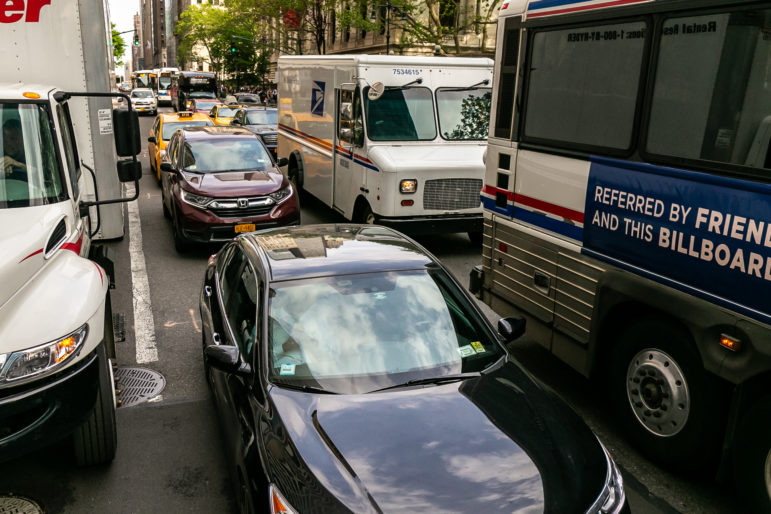“Congestion pricing is not just about alleviating traffic; it’s about recognizing that a future designed around the automobile is one of economic stagnation.”
Adi Talwar
Friday evening traffic heading West on 42nd Street between 5th and 6th Avenues in Manhattan.
CityViews are readers’ opinions, not those of City Limits. Add your voice today!
More than 100 days have passed since Gov. Kathy Hochul hit the brakes on New York City’s long-awaited congestion pricing plan, adding needless delays to a program poised to pull the city’s transportation infrastructure out of the dark ages and into a brighter, more economically vibrant and tech-forward future.
The months-long “pause” has already created a $840 million budget black hole for the MTA—a figure that represents not just lost operating funds, but a fundamental misunderstanding about how to fix the economic challenges facing New York City.
With buzz around the MTA’s board meeting last week (as well as the first trial date in a lawsuit challenging Hochul’s action on congestion pricing, ironically coinciding with ClimateWeek), it’s time for an honest discussion about the economic implications of delaying this critical initiative.
Hochul must reinstate congestion pricing to benefit the 5 million New Yorkers who rely on transit daily and the almost 1 million who use bikes and micromobility, and also because it is essential to the economic vitality of the entire city.
Congestion pricing is not just about alleviating traffic; it’s about recognizing that a future designed around the automobile is one of economic stagnation. One recent study found that traffic delays alone cost New York City $243 million every single year.
Now, factor in the lost productivity, the environmental damage of transportation emissions, the healthcare costs associated with poor air quality, and the opportunity cost of valuable urban space ceded to private storage (parking) instead of revenue-generating businesses. This is the cost of a car-dependent city, and it is simply not a future New York can afford.
The alternative—a car-lite city, enabled by robust public transit and a thriving micromobility sector—is not some utopian fantasy; it’s an economic imperative, as proven by cities like London, Singapore, and Stockholm.
These cities stand as testaments to the transformative power of congestion pricing; by making investments to modernize their transit systems and support non-car travel, they experienced a boom in economic activity. Further, Stockholm’s traffic reductions save the city the equivalent of $80 million per day through reductions in travel time, proving that a commitment to sustainable urban planning is a commitment to economic growth.
Competing with these global powerhouses should be a top priority for officials in New York. The city has touted its stance as a “leader on climate action” and has become known as the Silicon Valley of climate technology. We’ve already invested heavily in infrastructure and incentives to entice climate tech companies to locate here, and recent predictions estimate the green economy will generate 400,000 jobs by 2040. But we’re selling snake oil if we choose to sideline the very policies that are essential to supporting a sustainable climate future and green economy.
Hochul must embrace congestion pricing not as a tax, but as an investment in a future where New York City reclaims its streets, modernizes its infrastructure, and further secures its place as a global economic powerhouse. Where our aging population—the Baby Boomers—stay active and engaged in the economy thanks to transit accessibility improvements. Where businesses don’t just survive but thrive because their employees can easily access jobs, goods can move efficiently, and valuable real estate is dedicated to commerce, not car storage. This is the multi-faceted potential that congestion pricing unlocks.
And while our elected officials drag their feet, micromobility is already demonstrating the immense economic potential of a car-lite city. Micromobility has grown exponentially in both the consumer and commercial markets, becoming a default for personal trips and delivery operations. Despite limited infrastructure and a lack of supportive policies, this has made New York City a hotbed for micromobility startups, from vehicle manufacturers to charging infrastructure companies.
These companies see the writing on the wall—the future of global transportation is shared, electric, and efficient. Many of these businesses were drawn to New York City with the promise of congestion pricing, eager to be part of a city at the forefront of urban mobility. Stalling congestion pricing sends a chilling message to founders and investors, signaling a lack of commitment to building a 21st-century transportation network.
As we watch the time tick by and carbon emissions creep up, the choice before us is clear: We can continue to let traffic choke our streets and our economy, or we can choose a better path. By reinstating congestion pricing, Gov. Hochul has the opportunity to forge a legacy as the leader who actually steered New York City onto the path of sustainable growth and prosperity.
With the right action, we can create a city where the soundtrack is not the incessant honking of gridlock, but the gentle hum of micro-electric vehicles, the laughter of children playing in car-free streets, and the conversations of entrepreneurs building the businesses of the future in a place that embraces innovation.
Joseph and Eddie Cohen are the co-founders of Infinite Machine, a micromobility OEM developing the next generation of electric, non-car vehicles.


Leave a Reply